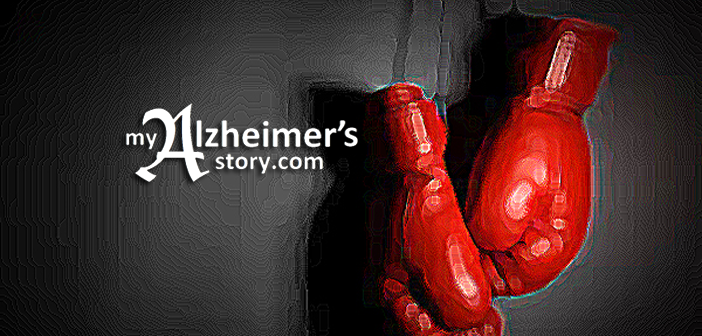
Note: this post has been shared thousands of times since I first published it. Also, Dr. John Morley, director of the division of geriatric medicine at Saint Louis University, one of the United States foremost authorities on geriatrics, and former editor of the Journal of America Medical Directors Association called the piece a “wonderful insight, which should be required reading for all persons who have to work with persons with Alzheimer’s disease.”
~~~~~~~~~~~~~~~~~~~~~~~~~~~
Imagine this:
It’s a bitterly cold winter night. You have recently been drafted into the role of caring for your father who has dementia. You are in his house in the country, miles from the nearest town. He is a BIG man. A strong man who has farmed the land he lives on for decades. He believes he’s somewhere else. In a strange hotel with strange people. And you are one of them.
Despite the fact that he thinks he doesn’t know you, he wants you to take him home. You argue for several hours. In the end, he begins to get physically aggressive. He tries to break a window when you block him from getting out the door. Years later you learn the situation could have been avoided. His aggression wasn’t his fault. It was yours.
I have learned through personal experience, reading and research that people living with dementia (PLWD) behave in logical, natural and understandable ways to stressful situations – just like most of the rest of us do. They react as any “normal” person would, but their behaviour is attributed to the disease rather than to whatever catalyst actually sparked it.
Many people with dementia are needlessly medicated for aggressive behaviour provoked by the environment and the people around them. Care partners need to find ways to hang up their boxing gloves instead of getting into the ring with people who live with dementia. Other dementia care pioneers share my belief that we can and should reduce, if not eliminate, the antipsychotic medication that is currently given to people with dementia to treat aggressive behaviour. It sedates PWD into compliance. I agree with dementia care experts such as Teepa Snow, Naomi Feil, Dr. Allen Power, Judy Berry, Eilon Caspi, and a growing wave of others who say that to provide compassionate care to PWD we need to see the world through their eyes.
20 questions
Here are 20 questions to ask yourself to help you understand why someone with dementia might get angry or aggressive:
- What would you do if you had to walk a mile in their shoes?
- How would you react if your children took your car keys away for no reason and told you couldn’t drive anymore?
- How would you react if people told you it was daytime when you knew for a fact it was the middle of the night?
- How would you respond if someone told you strangers would be coming to your house where you had lived alone for decades to take care of you because you couldn’t take care of yourself?
- What would you say if someone came and took your dog or cat away?
- How would you react if somebody kidnapped you from your home and took you to a prison full of sick and crazy people?
- What would you do if the people in the prison ordered you to sit down when you wanted to stand up? Or made you stand up when you wanted to sit down?
- How would you react if you wanted a drink and were told you couldn’t have one?
- How would you respond if you loved peace and quiet and you were surrounded by loud noises, and strangers who shouted, groaned and talked nonsense all the time?
- How would you react if people less than a quarter your age talked to you like you were a two-year old?
- What would you do if you wanted to escape, but all the doors were locked and you didn’t have a key? What would you do if you weren’t allowed out – ever?
- How would you react if somebody tried to force-feed you? What would you do if somebody made you swallow pills you knew would put you to sleep when you wanted to be awake?
- What would you do if a stranger tried to take something that belonged to you? What if they managed to get it and they wouldn’t give it back?
- How would you respond if someone told you weren’t allowed to go into your own room? Or open a door? Or close a drawer? Or pick something up? Or put something down? Or go outside? Or go inside? Or do whatever you wanted?
- What would you do if you were trapped, and you cried for help, and someone put you in a chair you couldn’t get out of and said you had to stay there?
- What if a stranger wanted to come to the bathroom with you? What if he tried to undress you? What if he put his hand between your legs and under your arms and under your breasts?
- What if you said you didn’t want to have a bath but people took your clothes off anyway and then they forced you into the bath and told you to calm down and be quiet?
- What if things like this happened every day? How would you feel?
- How would you express your feelings if you couldn’t find the words? What if you did find the words and no one listened?
- What would you do if you were alone and powerless? How would you react if you had no control over your own life? What if you felt incompetent, invisible and inconsequential?
What would you do?
Based on my own experience, research and training with Teepa Snow, I developed a process called “BANGS” to help myself and others avert “shoot outs” with people who live with dementia. It’s easy and it works. You can learn the steps and use it too.
Watch my free one-hour webinar on BANGS here, or see it in individual chunks at these links:
“A” is for assess, accept, and agree.
“G” is for go with their flow, let go of your ego, get over it, get on with it, get down to it
Download a PDF here: 20 Questions that Help Explain Dementia Aggression








